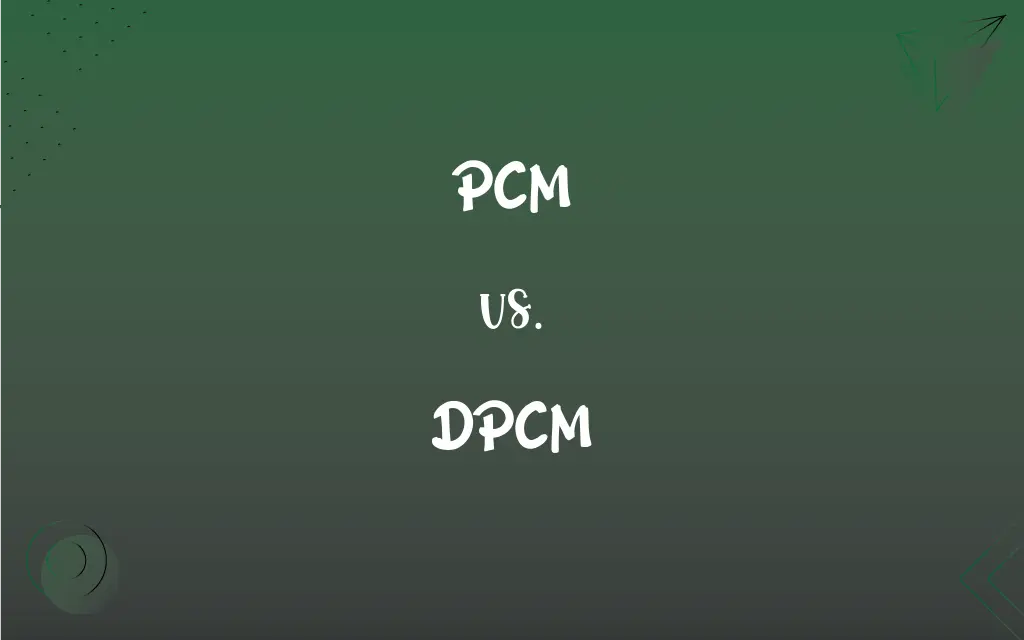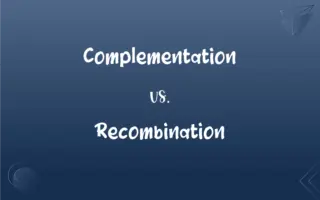PCM vs. DPCM: What's the Difference?
Edited by Aimie Carlson || By Janet White || Published on February 29, 2024
PCM (Pulse Code Modulation) converts analog signals into digital by sampling, while DPCM (Differential Pulse Code Modulation) encodes the difference between successive samples.

Key Differences
PCM, or Pulse Code Modulation, is a method used to digitally represent analog signals. In PCM, the amplitude of the analog signal is sampled at regular intervals and each sample is quantized to the nearest value within a range. DPCM, or Differential Pulse Code Modulation, is a variation of PCM. It records the difference between successive samples, rather than recording each sample independently.
In PCM, the entire signal is represented in digital form, which typically requires a larger bandwidth and more storage capacity. This method is straightforward but can be data-intensive. DPCM, on the other hand, focuses on the incremental changes between samples. This technique often results in reduced data rates because it only encodes differences, which are typically smaller than the full sample values.
The accuracy of PCM is generally higher since it represents the complete signal at each sampling point. This makes PCM ideal for high-quality audio and video applications where fidelity is critical. DPCM, being more efficient in terms of data, is used in applications where bandwidth is limited, but it can suffer from error accumulation over time.
PCM is simpler in terms of implementation and is less susceptible to error propagation, making it more reliable in certain applications. DPCM, though more complex, is advantageous in scenarios where reducing the amount of transmitted data is essential, as in wireless communication.
PCM's applications are diverse, including CDs and DVDs, where high fidelity is important. DPCM finds its use in more compressed formats and transmission systems, where bandwidth efficiency is a priority over absolute quality.
ADVERTISEMENT
Comparison Chart
Data Representation
Represents entire signal at each sampling point
Represents difference between successive samples
Bandwidth Usage
Requires more bandwidth
Uses less bandwidth due to data efficiency
Complexity
Simpler, straightforward implementation
More complex due to differential encoding
Application
Used in high-fidelity audio and video (e.g., CDs)
Used where bandwidth is limited (e.g., wireless transmission)
Error Propagation
Less susceptible to error propagation
More prone to error accumulation over time
ADVERTISEMENT
PCM and DPCM Definitions
PCM
PCM involves sampling an analog signal and quantizing it to a digital form.
In PCM, an analog audio waveform is sampled at regular intervals to convert it into digital data.
DPCM
DPCM reduces the bit rate compared to standard PCM.
Satellite communication systems may employ DPCM to reduce the amount of transmitted data.
PCM
PCM is used in digital telephone systems for voice transmission.
The voice calls we make over digital networks are often encoded using PCM.
DPCM
DPCM is a data compression technique derived from PCM.
DPCM is often used in voice transmission over limited-bandwidth channels.
PCM
PCM encodes the amplitude of the analog signal at discrete time intervals.
In video broadcasting, PCM is used to digitize video signals for transmission.
DPCM
DPCM can be more prone to error accumulation over time.
Wireless audio devices sometimes use DPCM, balancing quality with bandwidth efficiency.
PCM
PCM (Pulse Code Modulation) is a method to digitally represent analog signals.
Audio CDs use PCM to digitally store music tracks.
DPCM
DPCM (Differential Pulse Code Modulation) encodes differences between successive samples.
In DPCM, only the change in audio signal from one sample to the next is recorded.
PCM
PCM is fundamental in digital audio and video technology.
Modern music production heavily relies on PCM for recording and editing digital audio.
DPCM
DPCM is efficient for applications where bandwidth is a constraint.
In some video conferencing tools, DPCM is used to compress the audio signal.
PCM
(initialism) Per calendar month.
PCM
(initialism) per cent mille (1000 pcm = 1%)
FAQs
Where is PCM commonly used?
PCM is used in CDs, DVDs, and digital telephone networks.
How does PCM work?
PCM works by sampling the amplitude of an analog signal at regular intervals and quantizing it into a digital form.
How is DPCM different from PCM?
DPCM encodes the difference between successive samples instead of the entire signal.
What is PCM?
PCM stands for Pulse Code Modulation, a method to digitize analog signals.
What is DPCM?
DPCM stands for Differential Pulse Code Modulation, a variation of PCM encoding differences between samples.
Is PCM better in terms of quality than DPCM?
PCM generally offers higher fidelity, making it better for high-quality audio and video.
Is PCM used in mobile communications?
PCM is used, but less frequently in mobile communications due to its higher bandwidth requirements.
Does DPCM save bandwidth?
Yes, DPCM saves bandwidth by encoding only the changes between samples.
Why is DPCM preferred in certain applications?
DPCM is preferred for its efficiency in data transmission and storage.
Can DPCM result in errors?
Yes, DPCM can accumulate errors over time due to differential encoding.
Is PCM suitable for all types of digital audio?
PCM is suitable for most types, but its data-intensive nature may not be ideal for all scenarios.
Where is DPCM most effectively used?
DPCM is effective in compressed formats and limited bandwidth scenarios like wireless transmission.
Does DPCM have any quality loss?
DPCM can have quality loss, especially in scenarios with significant changes between samples.
Is PCM more costly to implement?
PCM can be more costly due to its higher data and storage requirements.
Are there error correction methods for PCM and DPCM?
Yes, there are error correction methods, but they are more straightforward for PCM.
How does DPCM improve data transmission efficiency?
DPCM improves efficiency by transmitting only incremental changes in the data.
Can DPCM be used for video transmission?
Yes, DPCM can be used for video transmission, particularly where bandwidth is limited.
Is PCM more data-intensive?
Yes, PCM tends to be more data-intensive due to its comprehensive sampling method.
What are the drawbacks of PCM?
The main drawback of PCM is its requirement for more bandwidth and storage.
Can PCM and DPCM be used interchangeably?
They can be used interchangeably in some contexts, but their effectiveness depends on specific application needs.
About Author
Written by
Janet WhiteJanet White has been an esteemed writer and blogger for Difference Wiki. Holding a Master's degree in Science and Medical Journalism from the prestigious Boston University, she has consistently demonstrated her expertise and passion for her field. When she's not immersed in her work, Janet relishes her time exercising, delving into a good book, and cherishing moments with friends and family.
Edited by
Aimie CarlsonAimie Carlson, holding a master's degree in English literature, is a fervent English language enthusiast. She lends her writing talents to Difference Wiki, a prominent website that specializes in comparisons, offering readers insightful analyses that both captivate and inform.







































































